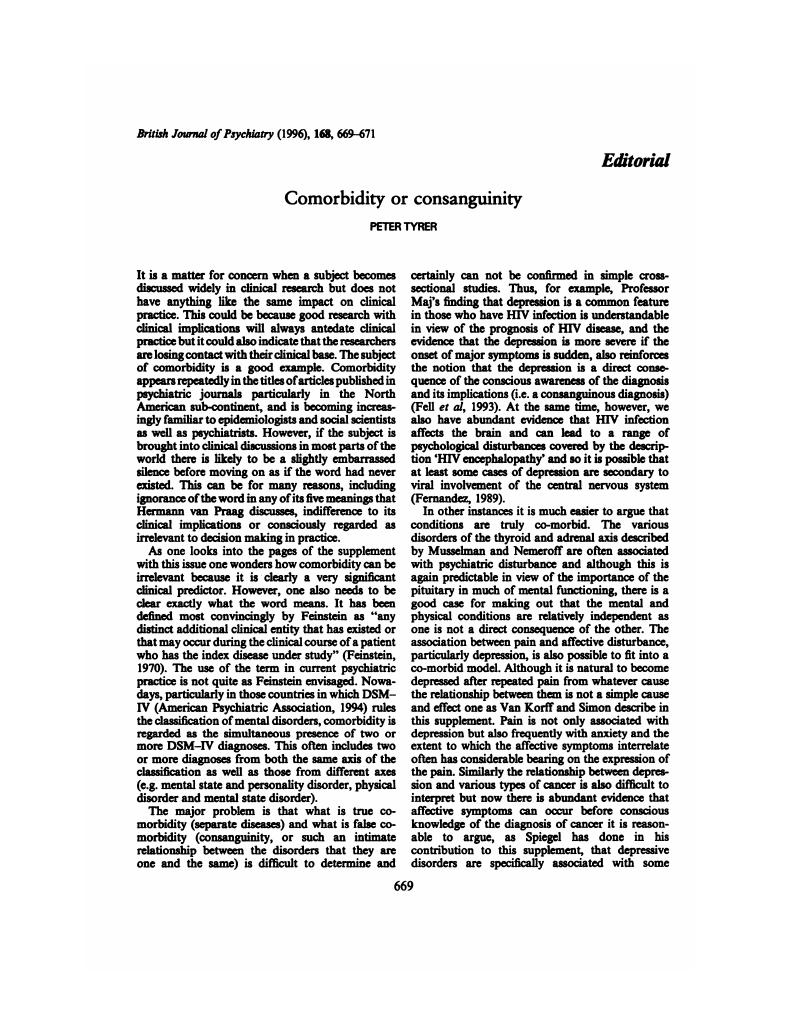Crossref Citations
This article has been cited by the following publications. This list is generated based on data provided by Crossref.
Lloyd, Keith R.
and
Weich, Scott
1997.
The epidemiological toolbox in psychiatry.
Current Opinion in Psychiatry,
Vol. 10,
Issue. 2,
p.
149.
Shwach, Raj S
1997.
Literature and history in medicine.
The Lancet,
Vol. 349,
Issue. 9062,
p.
1393.
Long, Nigel
Ronan, Kevin
and
Pereira-Laird, Joyce
1998.
Comprehensive Clinical Psychology.
p.
375.
Schoevers, R.A.
Beekman, A.T.F.
Deeg, D.J.H.
Geerlings, M.I.
Jonker, C.
and
Van Tilburg, W.
2000.
Risk factors for depression in later life; results of a prospective community based study (AMSTEL).
Journal of Affective Disorders,
Vol. 59,
Issue. 2,
p.
127.
Ramasubbu, Rajamannar
2000.
Relationship between depression and cerebrovascular disease: conceptual issues.
Journal of Affective Disorders,
Vol. 57,
Issue. 1-3,
p.
1.
Hilarski, Carolyn
and
Wodarski, John S.
2001.
Comorbid Substance Abuse and Mental Illness.
Journal of Social Work Practice in the Addictions,
Vol. 1,
Issue. 1,
p.
105.
Schoevers, R. A.
Beekman, A. T. F.
Deeg, D. J. H.
Jonker, C.
and
Tilburg, W. van
2003.
Comorbidity and risk‐patterns of depression, generalised anxiety disorder and mixed anxiety‐depression in later life: results from the AMSTEL study.
International Journal of Geriatric Psychiatry,
Vol. 18,
Issue. 11,
p.
994.
Tyrer, Peter
Seivewright, Helen
and
Johnson, Tony
2003.
The Core Elements of Neurosis: Mixed Anxiety-Depression (Cothymia) and Personality Disorder.
Journal of Personality Disorders,
Vol. 17,
Issue. 2,
p.
129.
Starcevic, Vladan
2005.
Psychiatric Comorbidity: Concepts, Controversies and Alternatives.
Australasian Psychiatry,
Vol. 13,
Issue. 4,
p.
375.
Smalbrugge, Martin
Jongenelis, Lineke
Pot, Anne Margriet
Beekman, Aartjan T. F.
and
Eefsting, Jan A.
2005.
Comorbidity of depression and anxiety in nursing home patients.
International Journal of Geriatric Psychiatry,
Vol. 20,
Issue. 3,
p.
218.
Starcevic, Vladan
2005.
Psychiatric Comorbidity: Concepts, Controversies and Alternatives.
Australasian Psychiatry,
Vol. 13,
Issue. 4,
p.
375.
Schoevers, Robert A.
Deeg, D.J.H.
van Tilburg, W.
and
Beekman, A.T.F.
2005.
Depression and Generalized Anxiety Disorder: Co-Occurrence and Longitudinal Patterns in Elderly Patients.
The American Journal of Geriatric Psychiatry,
Vol. 13,
Issue. 1,
p.
31.
Tyrer, Peter
and
Baldwin, David
2006.
Generalised anxiety disorder.
The Lancet,
Vol. 368,
Issue. 9553,
p.
2156.
Goosens, Martijn
Smulders, Sietske A.
Smeenk, Frank W.
Daniëls-Gooszen, Alette W.
Donkers-van Rossum, Astrid B.
Edelbroek, Michela A.
Huysmans, Dyde A.
Michels, Arent-Jan
van Straten, Bart A.H.M.
and
Postmus, Pieter E.
2007.
Influence of Introduction of Positron Emission Tomography on Adherence to Mediastinal Staging Protocols and Performance of Mediastinoscopy.
Journal of Oncology Practice,
Vol. 3,
Issue. 5,
p.
242.
Tyrer, Peter
Coombs, Natalie
Ibrahimi, Fatema
Mathilakath, Anand
Bajaj, Priya
Ranger, Maja
Rao, Bharti
and
Din, Raana
2007.
Critical developments in the assessment of personality disorder.
British Journal of Psychiatry,
Vol. 190,
Issue. S49,
p.
s51.
Taylor, Pamela J.
Hill, Jon
Bhagwagar, Zubin
Darjee, Rajan
and
Thomson, Lindsay D. G.
2008.
Presentations of psychosis with violence: variations in different jurisdictions. A comparison of patients with psychosis in the high security hospitals of Scotland and England.
Behavioral Sciences & the Law,
Vol. 26,
Issue. 5,
p.
585.
Critchfield, Kenneth L.
Clarkin, John F.
Levy, Kenneth N.
and
Kernberg, Otto F.
2008.
Organization of co‐occurring Axis II features in borderline personality disorder.
British Journal of Clinical Psychology,
Vol. 47,
Issue. 2,
p.
185.
Vink, Dagmar
Aartsen, Marja J.
Comijs, Hannie C.
Heymans, Martijn W.
Penninx, Brenda W.J.H.
Stek, Max L.
Deeg, Dorly J.H.
and
Beekman, Aartjan T.F.
2009.
Onset of Anxiety and Depression in the Aging Population: Comparison of Risk Factors in a 9-Year Prospective Study.
The American Journal of Geriatric Psychiatry,
Vol. 17,
Issue. 8,
p.
642.
Newton-Howes, Giles
Tyrer, Peter
Anagnostakis, Katina
Cooper, Sylvia
Bowden-Jones, Owen
and
Weaver, Tim
2010.
The prevalence of personality disorder, its comorbidity with mental state disorders, and its clinical significance in community mental health teams.
Social Psychiatry and Psychiatric Epidemiology,
Vol. 45,
Issue. 4,
p.
453.
Links, Paul S.
and
Eynan, Rahel
2013.
The Relationship Between Personality Disorders and Axis I Psychopathology: Deconstructing Comorbidity.
Annual Review of Clinical Psychology,
Vol. 9,
Issue. 1,
p.
529.




eLetters
No eLetters have been published for this article.